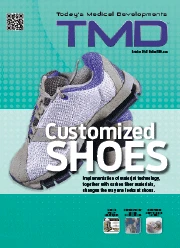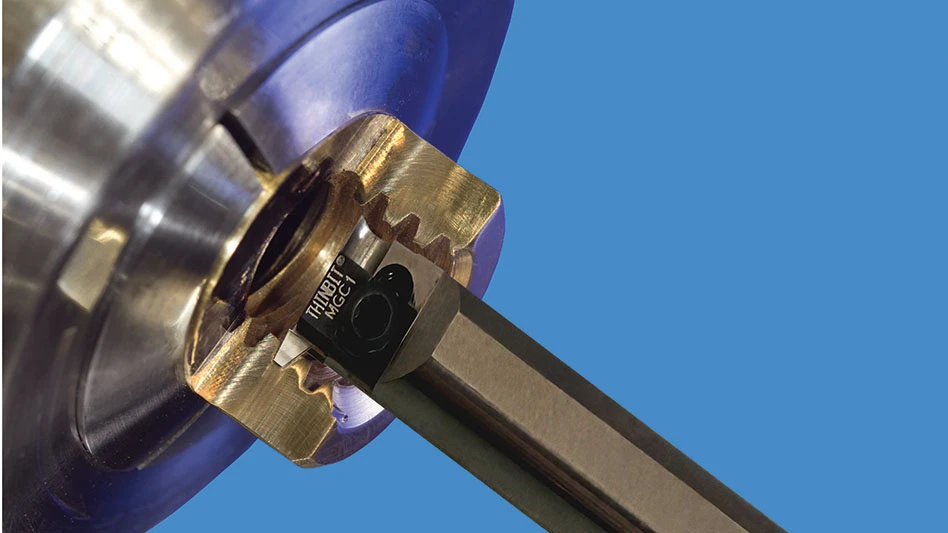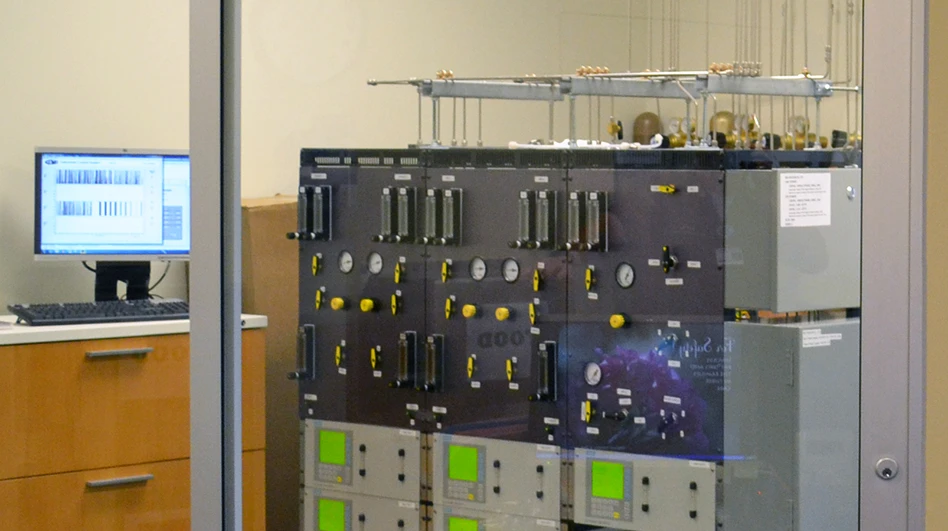.gif) Socket fit is a crucial component to the comfort and functionality of a prosthetic. Socket fit is a crucial component to the comfort and functionality of a prosthetic.When a socket does not fit, the typical practice is to throw it away and refit for a new one. |
Several years ago, “the U.S. Department of Defense Manufacturing Tec hnology Program (ManTech) was trying to determine if changes to prosthetics would be good for all military branches instead of just helping an Army ManTech, a Navy ManTech, or an Air Force ManTech,” states Christopher W. Norfolk, PhD, SCRA Applied R&D, Program Manager, Advanced Materials Division. “The project was focused on helping our nation’s wounded warriors, and not necessarily focusing on the actual device. We wanted to see what was occurring at the government-level, in the lab and at medical facilities, and where there could be improvements. We found that one thing they were still doing at all these facilities was fabricating sockets.”
So, in consultation with Walter Reed and the Center for the Intrepid, and starting with a Request for Information (RFI), the project began.
 One of SCRA’s projects was work to develop a system capable of measuring the pressure exerted on the 3D socket, utilizing the material previously proven in other medical applications. One of SCRA’s projects was work to develop a system capable of measuring the pressure exerted on the 3D socket, utilizing the material previously proven in other medical applications. |
SCRA has headquarters in Columbia, SC, as well as locations in Charleston, and Anderson, SC, (see sidebar). SCRA Applied R&D leads the Office of Naval Research (ONR) Composites Manufacturing Technology Center of Excellence (CMTC) for naval platforms. The CMTC is one of nine Centers of Excellence (COE) that serve as technology resources to ONR under the Navy Manufacturing Technology Program (Navy ManTech). The centers are focal points for the development of manufacturing processes and equipment in a cooperative environment with industry, academia, and Navy industrial facilities and laboratories.
With the collaboration in place between SCRA, ONR, and CMTC, and ideas collected via Walter Reed and the Center for the Intrepid, a workshop was held, issues discussed, and four ideas were narrowed down that required pursuing, with a fifth still actively in the works.
.gif) Reconfigurable Materials
Reconfigurable Materials
Socket fit is a crucial component to the comfort and functionality of a prosthetic. When a socket does not fit, the typical practice is to throw it away and refit for a new one. There are several reasons that sockets can change throughout their lifecycles: atrophy, reduced volume of the limb, and heterotopic ossification (an abnormal growth of bone, usually in soft tissue) can occur, all resulting in needed alterations to the geometry of the socket.
These changes can cause negative volume changes, which normally require the formation of a new socket. They can also result in a positive volume change in localized areas, requiring the extra material in the socket to be ground away – negatively affecting the strength of the part. Sometimes parasitic weight is added to the interior surface of the socket, knowing that a positive volume change may occur in the future and that the addition can be removed. Unfortunately, the addition of this weight significantly increases the socket weight.
Addressing these concerns, SCRA pursued two competitive solutions. One was in conjunction with Clemson University, Clemson, SC, and the other with Composites Technology Development (CTD), Lafayette, CO. The Clemson approach is more academic and not as easily scaled up, but the CTD solution is much farther along in the commercialization process.
“CTD specializes in shape memory composites, where fabrication of the composite occurs followed by the application of heat. Once heated, there can be adjustment of the composites with regard to form and fit and, upon cooling, it will maintain this new shape. Once reheated, it will return to its originally fabricated shape. The benefits of this are the ability to remold and reshape over time as the shape and size of the socket changes,” Norfolk explains.
“Additionally, the material is available in a resin, which attaches to carbon fabrics, and is available as foam. The foam delivers unique properties: the user can either compress the foam or expand the foam prior to use. In the compressed stage, the foam goes into the socket, heat is applied, expanding in the interior volume of the socket. Alternately, fully expanded foam can be placed in the socket’s interior, and heat can be applied to compress the foam to fit,” Norfolk says.
With foam that can see implementation for both positive and negative change, the fitting of sockets can occur with more comfort, less waste, and more ease. All material is currently available on the open market, and although there is no commercial implementation yet, it is a viable alternative on the horizon.
| What is SCRA? SCRA is a non-stock, tax-exempt applied research corporation with headquarters in South Carolina. SCRA, started by the SC Legislature under a public charter to help develop technology-based industries in the state, began in 1983 with a founding grant of $500,000 and 1,400 undeveloped acres. It has been self-sufficient for funding since that time, with the generation of revenues primarily through competitively won applied research contracts awarded by the federal government and about 200 corporations. SCRA has three key missions which define our divisions: SCRA Technology Ventures; SCRA Applied R&D; and SCRA R&D Facilities. www.scra.org |
FEA Modeling via MRIs
Part two of SCRA’s project was an effort to map prosthetic sockets through MRI scanning of a patient’s residual limb. The goal of this task was to generate a socket based on the underlying anatomical structures while assessing the pressures those sockets would impose on the residual limb through finite element analysis (FEA). This approach, in conjunction with Georgia Tech and Emory University, hopes to create a virtually-designed socket with inherent comfort, right from the beginning.
“Well, this was an extremely ambitious project, to say the least,” Norfolk admits. “There are many areas of modeling that the user needs to be able to verify before further extending the model, and that was one issue we encountered. The other issue was using an MRI on a patient that has lost a limb, MRIs are not the standard of care for patients that have lost a limb. Because that data is not currently used, it was difficult to explain why we would subject a patient to a procedure that is not needed. Also, many patients have shrapnel type wounds, so those patients are not able to have an MRI.”
Even though this topic of research did not advance as initially planned, and SCRA’s funding for it has ended, university researchers who make their careers working on projects such as this are still investigating to see if they can parameterize the residual limb through use of key measurements, such as the distance between the tibia, fibula heads, distance between various anatomical parts, etc.
Pressure Mapping
Third in SCRA’s work was to develop a system capable of measuring the pressure exerted on the 3D socket, utilizing the material previously proven in other medical applications. The material is a plastic with some additives, which allows for large changes in surface resistivity under the application of relatively small loads.
“Similar systems are available,” Norfolk explains, “however, the number of points measured is relatively small.” In response to this issue, SCRA developed a product that would allow the user to map the entire residual limb. The patient is able to wear it for quite a long time, which allows the collection of massive amounts of data on the pressures that the residual limb exerts on the socket and that the socket exerts on the residual limb.
“The result of this research is in commercial use and is available as the SensorTech Zebra System, already adopted for use by some research-level clinicians. Furthering this development is its extension into orthotics use, which deals more with fitting of braces, as well as use in measuring the pressure wave that occurs during blast events as part of an effort to try to quantify traumatic brain injury events,” Norfolk notes.
| What does SCRA do? SCRA has three key missions that define our divisions:
|
Molds and Braiding
“Probably the largest part of this project was the idea that if you designed a socket virtually, it makes very little sense to take a plaster cast of the residual limb and base all of your fabrication cycles off this plaster cast of the patient,” Norfolk explains. “If the shape and size of the socket is known via the virtual design it makes the most sense to fabricate it automatically, using that data.”
In response to this, SCRA reviewed a few different ways to cut a mold that would be less expensive than using plaster. Starting with machineable wax, a CNC machine cuts a mold based off the digital design of the socket. Once there is the creation of the positive mold, the plan was to utilize the braiding technology from the composites industry which places the fiber directly onto the mold.
“Implementing the braiding process with the positive mold meant that we braided the carbon fiber down onto the mold and then infused it in a wet infusion process – similar to what already occurs in the prosthetic industry,” Norfolk describes. “However, the interesting development was a major cost savings, – decreased labor combined with a cost savings for the molds ended up reducing costs by nearly 40%.”
“Beyond the cost savings, the other notable improvement was the strength increase and weight reduction of sockets. Utilization of the braiding technique versus a traditional hand lay-up method resulted in the same amount of carbon use, but weight was reduced by nearly half, and at the same time its strength was doubled.”
Working with SCRA officials, Mentis Sciences Inc., Manchester, NH, developed the braider used in the research for socket production. Immediately, the industry took notice of the technique and the advantages it delivers to those in the orthotics and prosthetics market. Currently, two fabrication facilities have invested in purchasing braider machines – Friddle’s Orthopedic Appliances, Honea Path, SC, and O&P One, Waterloo, IA, with Mentis Sciences retaining the original braider made for SCRA’s research.
.gif) Continual development in lighter-weight and more comfortable prosthetics enables individuals to lead active, productive lives. Continual development in lighter-weight and more comfortable prosthetics enables individuals to lead active, productive lives. |
Future Work
One last task under investigation by SCRA is for an active cooling system, which would be incorporated into the liner to reduce overheating in the residual limb. Although there is not much funding for SCRA to pursue this topic, it is a high-priority issue – especially to prosthetic users.
“In typical prosthetic wear, amputees wear socks right up against their skin. Next, for the true comfort of the wearer is the liner made of a gel material. Then, the composite socket attaches over the top of the liner,” Norfolk explains in detail. “So, you have now wrapped the entire residual limb in a system that does not transmit heat very well, which is very uncomfortable, especially for athletes that wear prosthetics in high-energy sports. In addition, when you localize the heat you start sweating, causing a loss of volume in the residual limb, affecting the fit of the system, and, additionally, the sweat also acts like a lubricant.”
The combination of volume loss and sweat results in the prosthetic sliding around, causing discomfort for the wearer – especially affecting those users of prosthetics that participate in sporting events where slippage of the prosthetic can impact their performance.
“It was a response to us from veterans that this was really an area of need for them,” Norfolk states. “So, currently in development, is an active system, which we hope to take to market before year-end. There will be adjustments and tweaks with it, as it includes an accessory pack that runs the system, but first we want to get positive results from users and then we will work on reducing the weight of the accessory pack for optimal use.”
In the end, it really is never ending project for SCRA. With strong working relationships within the ManTech community, and the fact that SCRA assembles teams and manages teams to rapidly apply research and development to new applications, one really looks forward to seeing what is on the horizon.
|
SCRA is a powerhouse for commercialization that takes discoveries out of the lab and off the bench. They are selected, perfected, and then taken into production and widespread use, achieving typical transition rates of 70% to 80%. SCRA leads 100 national and international research programs with more than $1.5B in contract value. SCRA-led collaborations are virtual businesses that orchestrate the efforts of multiple organizations. SCRA acts as an objective, trusted agent, choosing the best sources to deliver technology solutions to complex client challenges. www.scra.org |
SCRA
Charleston, SC
www.scra.org

Explore the October 2012 Issue
Check out more from this issue and find your next story to read.
Latest from Today's Medical Developments
- Betacom, Siemens launch 5G network platform to accelerate manufacturing innovation
- Starrett’s AVR400 CNC vision system
- US cutting tools orders decreased 2% from November 2024
- SMW Autoblok's Manual Jack connection kit
- MedTech Innovator welcomes five new industry partners
- First Article Inspection for quality control
- The manufacturing resurgence is here – are you ready?
- Workholding solutions for your business
 Leaders in Collaboration
Leaders in Collaboration




